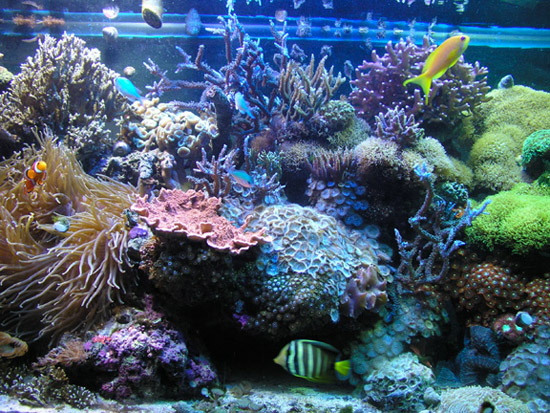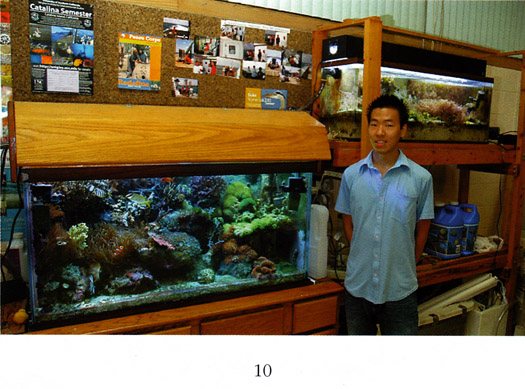Part 1….90 Gallon Caribbean reef biotope at the University of Miami
For the past several months we have been working in conjunction with the marine science laboratory at the University of Miami and the UM Aquarium Club (UMAC) in the development of a 90-gallon Caribbean reef biotope. The backstory as to how and why we got involved in this project is more or less as follows…

(above) UM MSC 90-Gallon around it’s heyday (2005-ish)
I attended the marine biology program at the University of Miami from 2000 to 2004. In the fall of 2002, I was accepted into the exchange program with James Cook University on the Great Barrier Reef in Australia to study tropical marine ecology and aquaculture. At that time, I had a 90 gallon mixed coral reef tank setup at my house. Going abroad for a semester certainly imperiled the future of my tank. Instead of selling the tank, I decided that it would be better put to use by donating it to the marine science lab at UM. Such a display would provide an insight into the lives of coral reef organisms to the students in the marine biology program.
My decision to attend the University of Miami was based almost solely on my ability to be nearer to the coral reefs, and the marine aquarium trade. However, when I arrived for classes as a freshman, I was surprised to find that none of the marine bio students were interested in keeping aquariums. More surprising to me was that none of my professors had much practical experience keeping ornamental aquariums, let alone growing corals. Some, in fact, seemed to have serious reservations towards marine aquarium trade in general.
So with this in mind, I felt that it was important to share with the marine science program my 90 gallon reef aquarium, as I strongly believe that conscientious reef aquariums can be powerful educational tools. The more people exposed to the secret lives of the coral reef creatures, the better in my book. Also, I’d be able continue maintaining and enjoying it once I returned from Australia…
I dismantled my tank and moved it into the Marine Science laboratory (MSC lab) several months before going abroad. The reef structure was constructed with about 150 pounds of premium Tampa Bay aquacultured live rock courtesy of my good friend, and aquacultured live rock pioneer Roy Herndon. We subsequently stocked the tank with corals that Roy was aquaculturing at his sizable green house farm. In hindsight, many of the corals selected for the initial stocking probably weren’t compatible for long term success of the tank, but for several years this tank was truly awesome in the breadth of species contained within such a small space.
At the time of installation, I took advatage of an empty 55 gallon glass aquarium that was going unused in the MSC lab. I had the side pane drilled, and installed a bulkhead. I then filled it up with about 6 inches of aragonite sand to create a deep sand bed. I put this tank above the 90 gallon display, such that a small pump would pump water from the display into this deep sand bed(DSB) refugium. Therefore, the refugium could truly act as a refuge, and small critters (i.e copepods, amphipods, etc) could flow naturally back into the main tank without being mascerated by a pump impeller. Macroalgae, anemones, and hardy corals would eventually establish residence in this protected area. Over the years this DSB refugium would prove extremely valuable in establishing stable water chemistry and long term success.
At the height of my involvement with the tank, I cataloged over 100 anthozoan (coral, corallimorph, anemone) species and morphs. I literally packed in everything: SPS, LPS, soft corals, corallimorphs, zoanthids, and anemones. In hindsight I chalk this up to exuberant youth…
You can see more or less what the overall tank system looked like in Julian Sprung and Charles Delbeek’s The Reef Aquarium Vol. 3 (Which we strongly recommend you own). It is the first tank featured in the book, on page 10, under the section titled “Why we need reef aquariums”. To sum it all up they write that reef aquariums “have become a tool for introducing students to coral reef ecology”. This was my exact sentiment in donating my reef tank to the MSC lab. Put more simply, reef aquariums are valuable educational tools.
I graduated in 2004 and moved outside the realm of the university, but came back periodically to check up on the tank. A younger student, Ben West (pictured with the tank in The Reef Aquarium vol. 3) , took over the day-to-day responsibilities of maintaining the tank.

The tank continued to prosper, but it’s success began to edge towards failure. As the unoccupied real estate of the tank shrank (as the corals grew happily), a turf war began to be waged in earnest. The notable “winners” of this war were Briareum sp. star polyps, and an Entacmea quadricolor anemone that grew to over 14 inches in diameter. The species diversity began to wane as colonies were either overgrown or stung to death. But this would be a successful failure in my book, as
In the fall of 2007 I came into the lab to check on the aquarium for the first time since I had left for Indonesia a year earlier. I finally came to the conclusion that there was no longer any point to the continuation of the tank at status quo. A serious overhaul was in order. Controlling the star polyps was not feasible, and the anemone was inextricable.
Furthermore, I had decided that to best maximize the educational potential of a coral reef aquarium at the University of Miami, would be to develop a Caribbean biotope reef. As a marine life collector I am in the position to stock the tank with local species, making it the perfect educational display for the marine science lab at the University of Miami.
More to come regarding this cool, new biotope aquarium…
